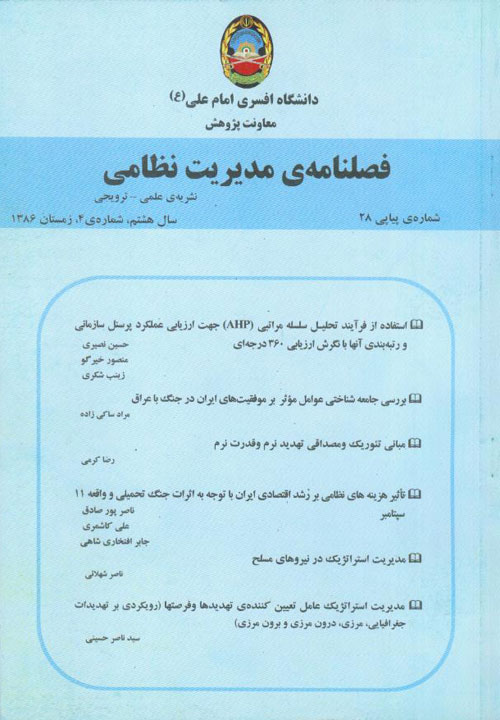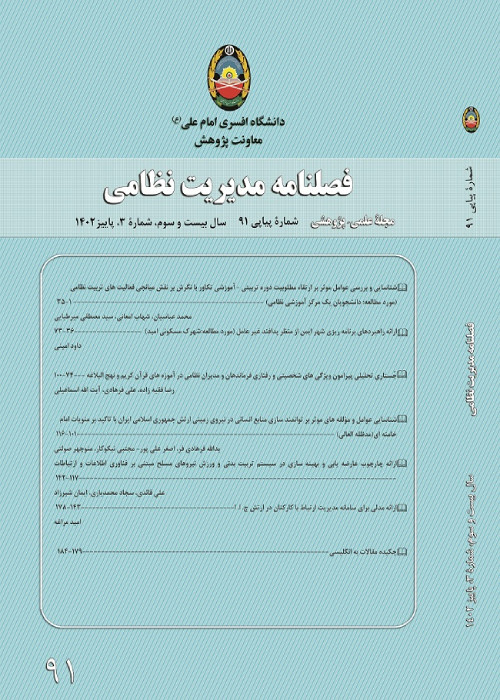فهرست مطالب

فصلنامه مدیریت نظامی
پیاپی 28 (زمستان 1386)
- تاریخ انتشار: 1386/10/10
- تعداد عناوین: 6
-
صفحه 101
-
مدیریت استراتژیک عامل تعیین کننده تهدیدها و فرصت ها / رویکردی بر تهدیدات جغرافیایی، مرزی، درون مرزی و برون مرزیصفحه 141
-
Page 1Evaluation of the performance of personnel is taken as one of the subjects of the management science and it enjoys a prime significance in management decisions. It means that the data collected through evaluation procedures are considered as a rational foundation as far as many of the administration and employment decisions are concerned and they entail enhancement of job satisfaction and higher performance of the labor force. Naturally, this process augments effectiveness and efficiency of public organizations. This study is an attempt to utilize qualitative perspectives in management in order to make the AHP approach as much effective as possible in administration system. To this end, the AHP approach was employed as to the evaluation of respective personnel in public organizations. The approach was also combined with the 360 degree evaluation procedure addressing both senior managers and their subordinators so that the management process can be completed as to a reliable and effective evaluation process.Keywords: Analysis, AHP, Evaluation, Matrix, Comparison
-
Page 26Subsequent to a full-fledged assault launched by the Iraqi Army and the resultant occupation of many Iranian border cities and villages, the Iranian Army was assigned to first stop further advancements of the invader, and then liberates the occupied lands. In the second year of the War; September 26, 1981-May 24, 1982, which should be identified as a Golden Year for Iran given the breakthrough victories, four great and destiny-changing military operations were planned and through active involvement of the Iranian nation in the form of popular forces called Basiij implemented. Consequently, the occupied lands were liberated and Iran managed to enjoy a dominant military position. Such an achievement could be attributed to various parameters that among them active public participation in the War, cooperation and unity between the Iranian Army and the Islamic Revolution Guard Corps, higher motivation and willingness to fight among the Iranian forces and taking the advantages of the weak points of the enemy forces are the most significant ones.
-
Page 41Given its abstract nature, concept of threat has always been contaminated with some degree of ambiguity. Each of the various approaches to national security, depending on their principles, interprets and defines the concept in a certain way (ranging from purely soft-ware to purely hard-ware in nature while some moderate version in between) on one hand, and it could also be said that in these approaches the nature of threat is commonly associated with certain degree of capability and power likely to affect interests and values of the opponent power at the expense of securing interests of the threatening power. In addition to trying to elaborate on the way soft threat develops, this study addresses its theoretical dimensions as well as any other pertinent issues like its aspects and application mechanisms. Given some considerations, however, examples of soft threat and power are not treated in this study.Keywords: Threat, Soft threat, Soft powrer, Security, National Security, Government ideas, Media
-
Page 73This article investigates the impacts of the military expenses on the economic development and growth of the I.R. of Iran during the period of 1974-2005 along with the respective impacts of the Iran- Iraq 8-year Imposed War and the September 11, 2001. To this end, Traditional Production Model was employed based on which the effects of the military section, balance of payments, savings, task force, the War and the September 11 event on the economic growth are addressed. The analysis made based on the Model shows that the military expenses and trade balance have had significant impacts on the economic development of Iran. In other words, increased share of the military expenses in Gross National Product (GNP) has entailed the improvement of trade balance which is believed to be a positive impact on the economic development. Variables of task force and per capita GNP indicate positive effects in this respect. On the contrary, the findings show negative impacts resulting from the variables of the War and the September 11 event on the economic development of Iran.Keywords: Economic growth, Military expenses, War, September 11 event, Balance of payments, Task force, Savings
-
Page 101Strategic Management (SM) refers to a futuristic, long-term, cohesive, developmental, and environmentally change-oriented management approach. Passing through a respective trend, such a notion of management develops a certain strategy through which and exercising necessary monitoring policy on it materiliazation of any assigned mission can be feasible in the best possible way. For the Iranian Military forces endowed with the responsibility of providing security, national interests, sovereignty and protecting government system, the achievement of these objectives would be possible or facilitated provided that appropriate military strategies can be developed. It is to this end that the present article attempts to introduce the reader into some fundamental knowledge and concepts on the SM, to suggest a sound management model of administration and command for the Iranian Military in an everchanging environment, to orient it with the methods of taking the advantages of the strengths and opportunities, to eliminate the weaknesses and to avoid the threats.Keywords: Prospect, Environment Analysis, Objectives, Strategy, Politic
-
Page 141Historically, man has always lived in insecure state and cohabited with various types of dangers. Various geographical, political, socio-cultural, economic, military and environmental phenomena have intensified the sources of threats against man. Geography either its physical or metaphysical environment has accommodated an extensive range of the threats. To this end, this study, as a library and descriptive research, is an attempt to introduce some of these threats identified as geographical (i.e., territorial, internal and oversea) in nature and while categorizing such threats, it considers the probability of their occurrence in the geographical basin of human societies unavoidable. Finally, it is hypothesized that man as a thoughtful agent relying on his intelligence, rationality, innovation and creativity is capable enough of strategically managing the threats and converting latent threats into active opportunities.Keywords: Geography, Geopolitic, Threath, Boundary, Strategical Management


